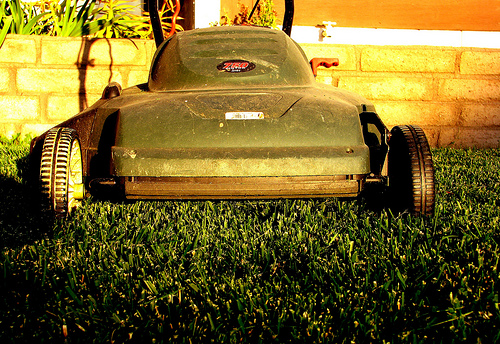50% Off First Application¹
Call 1-855-940-1479
and connect with a TruGreen consultant
Proper Lawn Maintenance is the Key to a Healthy Lawn
A yard full of healthy grass is the goal of every homeowner, but if you have been neglecting regular lawn maintenance your dreams may be out of reach. Frequent mowing, weeding, and irrigation are all important steps on your journey to the lawn you’ve been picturing. Read on to find out more about the best lawn maintenance practices for your yard.
Mowing
You may consider mowing to be purely an aesthetic choice, but mowing is one of the most important lawn maintenance practices. Mowing removes all sorts of potential issues in your lawn, including irregular growth patterns. By keeping all of the grass in your yard trimmed to a uniform length you can ensure a proper distribution of resources in new growth. That’s not all, frequent mowing can also help combat thatching and pest problems.
Throughout the year you should change the height of the blade on your lawn mower, but you must first determine the ideal height range for the type of grass in your lawn. Here are some of the ideal height ranges for some of the most common types of grass found in American lawns:
| Type of Grass | Ideal Height (inches) |
| Bahiagrass | 2 – 4 |
| Bentgrass | ¼ – ¾ |
| Bermudagrass | ½ – 2 |
| Buffalograss | 2 – 3 |
| Centipedegrass | 1 ½ – 2 ½ |
| Fescue | 2 ½ – 3 |
| Kentucky Bluegrass | 1 ½ – 2 ½ |
| Perennial Ryegrass | 1 ½ – 2 ½ |
| St Augustine | 2 – 4 |
| Zoysiagrass | ¾ – 2 |
During warm seasons, such as summer, you should keep your mower’s blade at the highest recommended setting to achieve the proper height. As weather grows colder you’ll want to lower the blade, one setting at a time. By the final mowing before winter arrives you want to cut your grass to the lowest recommended length from the table above.

Weeding
Weeds present a problem in every state in the country. Removing weeds by hand adds a lot to the time spent on your lawn’s needs. The best way to combat weeds is to target them before they sprout roots in your soil. This is done using pre-emergent weed control treatments. There are many herbicides that are available for this type of treatment, the challenge is identifying the best time to apply them. If these herbicides are applied even just a few days after roots have formed on weeds they will prove to be completely ineffective. Getting the timing perfect may depend on the type of weeds that are found in your area, but generally applying pre-emergent treatments on the 15th of both March and September will eliminate any problems.
If you are not comfortable with using herbicides in your yard there is very little that can be done other than manual weeding. When weeding your yard by hand make sure to get a firm grip on the base of the plant on pull up with weight distributed evenly. This way the root of the weed will come up along with the plant, preventing the weed from growing back soon after you remove it.
Irrigation
Every type of grass requires proper irrigation to thrive. Some types of lawns require more frequent watering than others, and depending on the rainfall patterns in your area you may not need to manually water your lawn often, if at all. Take some time to research the type of grass that is planted in your yard and monitor the amount of rain that your lawn sees from week to week. During seasons where rainfall is infrequent you may need to supplement irrigation using a sprinkler system.

TruGreen will gladly visit your property as often as needed between scheduled visits to make any necessary adjustments and to ensure your satisfaction.
Getting Started with TruGreen
- Call or fill out the form above to reach a lawn care specialist.
- Know the square footage of your yard, as well as any specific areas of concern.
- With the help of your specialist, create a customized lawn care plan that meets your lawn’s needs.
- Schedule your Healthy Lawn Analysis2 to start your service.
